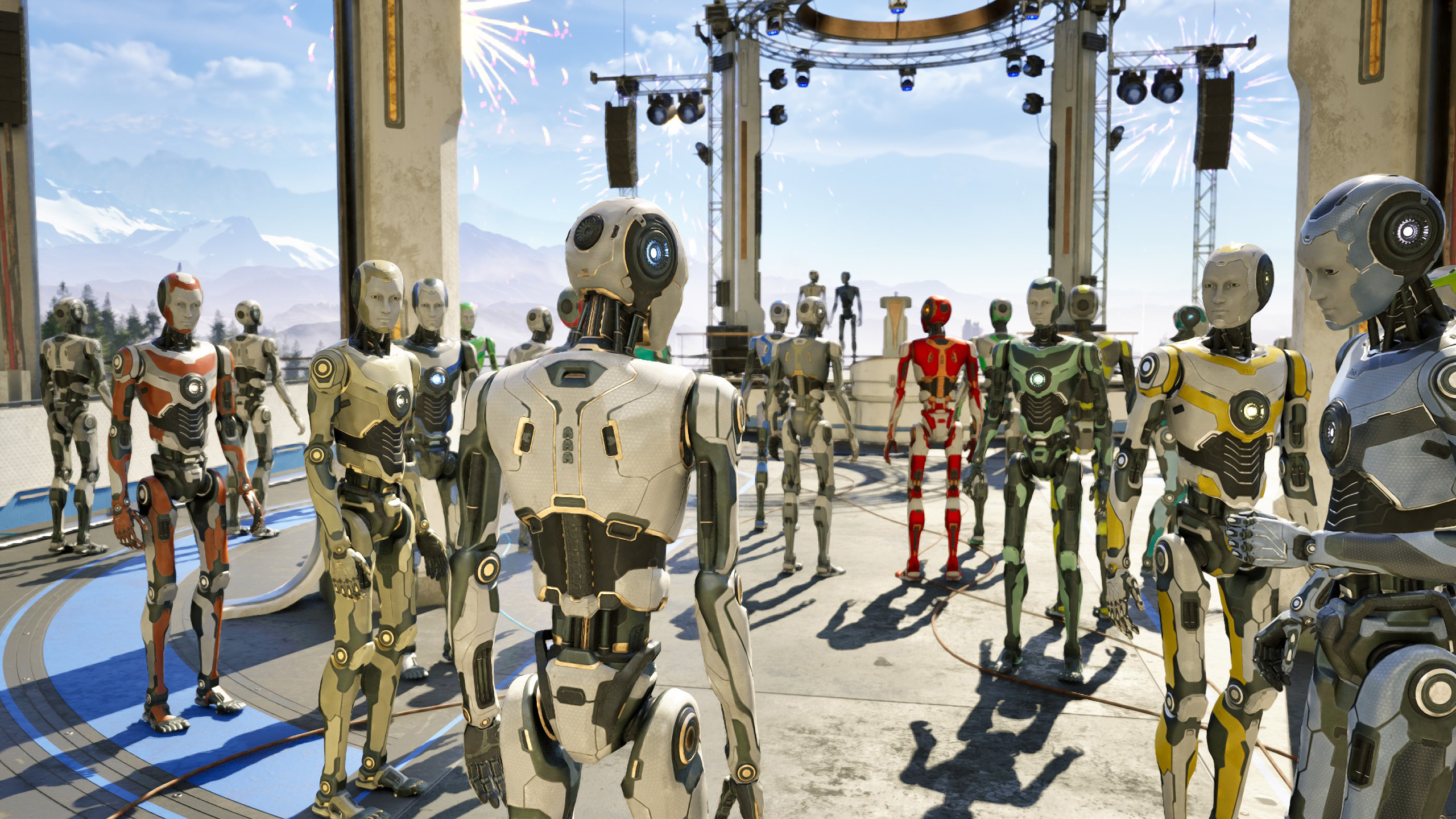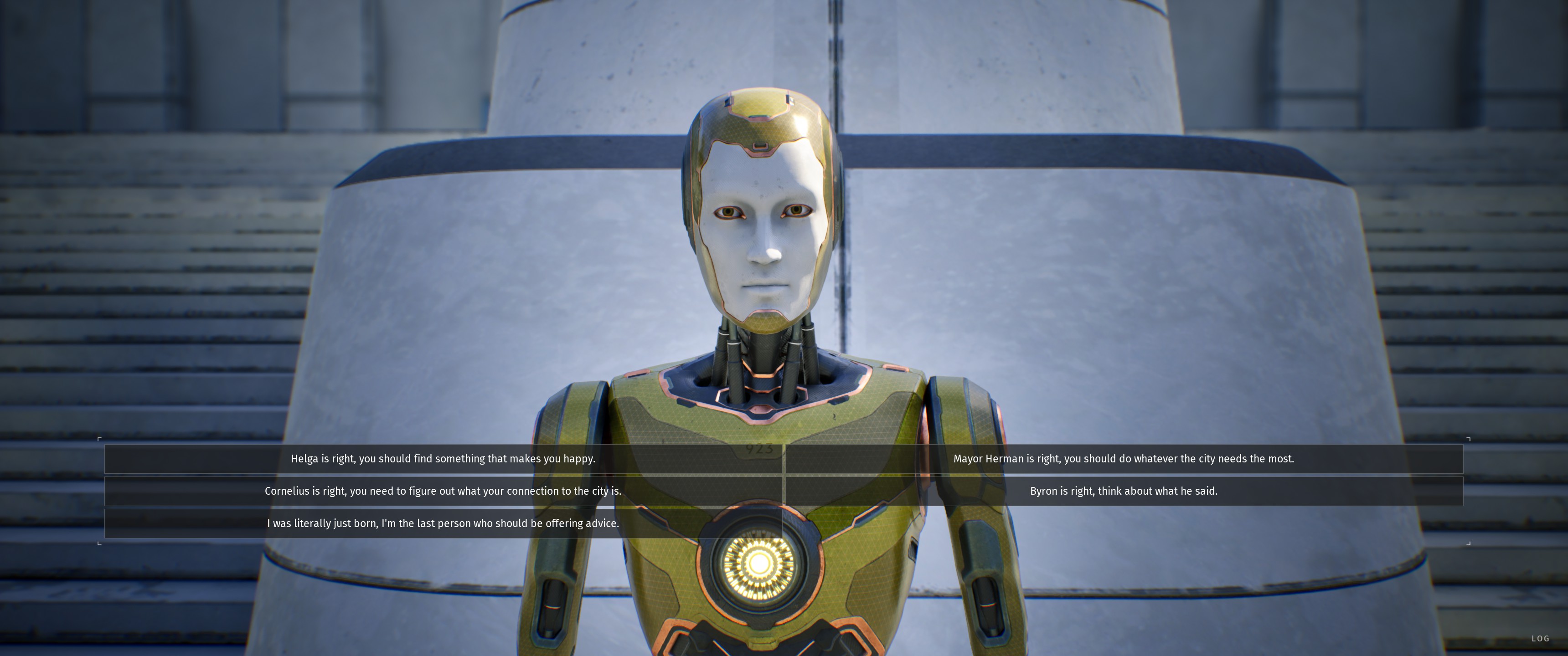Our Verdict
Not just a great sequel, but a thoughtful and human narrative adventure wrapped in a satisfying and beautiful puzzle game.
PC Gamer's got your back
What is it? Portal-esque spatial puzzling wrapped in a grand philosophical sci-fi narrative
Release date November 2, 2023
Expect to pay $30/£25
Developer Croteam
Publisher Devolver Digital
Reviewed on Windows 11, Nvidia RTX 4090, Intel i9 13900K, 64GB RAM
Steam Deck Playable
Link Official site
A good puzzle game is a compelling collection of brainteasers, but a great puzzle game provides compelling context to drive the player forward. The original Talos Principle balanced its Portal-esque first-person puzzles with philosophical introspection, examining what defines humanity, and quizzing the player on what they think, too. Its sequel confidently builds on its puzzle mechanics, but turns its narrative outwards, asking both the player and its own world: "What is a civilization?" The answer, I think, is "something beautiful".
For those skipping the first Talos Principle (still a great game, especially in VR), humanity is donezo, wiped out by a deadly virus. Before the curtains fell on us, scientists created a simulation to cultivate a new, synthetic human race through philosophical and puzzle-based testing. Think Portal, but with less malevolent AI, and more multi-choice quizzes on fundamental humanity. The first game ended as you emerged from this simulation as the first Human 2.0. In this sequel, you're the thousandth, beginning with your 'birth' into the real world.
While the first game was primarily focused on puzzle-solving and used its multi-choice philosophical quizzing as framing, Talos 2 hits around an even split, bringing the narrative to the forefront. The first game would strain to support that, being a lonely, solipsistic adventure, but here it works as there's a whole civilization of robo-people wandering around to chat with and debate via quaint forum discussions or face-to-face.
More human than human
They might have metal bodies, but the cast are every bit as cantankerous, contradictory, charming and cat-loving as flesh-humans, all well-voiced and written. Their philosophical quandaries tend to be grounded in real-world problems. Is it ethical for civilization to grow when humans previously damaged the world so badly? Is the pursuit of progress an inherently positive goal? Just how many (mechanical) humans is enough? There's no easy or even right answers, but the game wants to hear your thoughts anyway, and while many of the conversations are optional, I found almost all of the dialogue and debate to be deeply compelling and fully worthwhile.
The puzzles themselves feel perfectly tuned for a squishy-brained creature such as myself.
But, this being a puzzle adventure game and not just a chat about philosophy, there are pressing questions presented by a mysterious megastructure that's been discovered on a remote island, namely what its presence means for their nascent robot civilization. Previously, the machine-folk thought themselves the only sapient creatures around, and they've been more focused on building puzzle museums and a heart wrenching memorial to all the cats they've loved and lost, presumably populated with photos and thoughts on the dev team's former feline friends.
Following in the first game's footsteps, investigating this mystery cyber-pyramid involves puzzles, mythological allegory and gorgeous scenery. Talos 2 is broken up into twelve zones. Roughly split up into four climates (temperate, nordic, desert, etc), each region is a distinct, painfully photogenic environment you're encouraged to freely roam. Some are densely forested plains, others foggy mountaintops, and all are fantastic excuses to play around with the photo mode.

Primarily though, you'll be tackling self-contained spatial puzzles (eight mandatory, two optional and a few secrets per area) as you see fit. This being the same studio as Serious Sam, it's no surprise that secrets and bonuses in the form of puzzle-skipping tokens are hidden seemingly under every other rock, making exploration materially and aesthetically rewarding.
The puzzles themselves feel perfectly tuned for a squishy-brained creature such as myself. They're small, self-contained challenges, each one using a handful of moving parts, similar to Portal's test chambers, but with more varied puzzle pieces. Rather than relying on a single tool like a portal gun, each chamber contains an assortment of devices to pick up and move around. Some as simple as blocks to stand on or hold down buttons, but mostly you'll be redirecting color-coded lasers to matching receivers, bypassing force-fields, rerouting bounce-pads and more.
Talos 2 builds on that format, trimming out the least interesting parts of the first game (such as mines and gun turrets) in favor of more complex interactions between gadgets. Previously simple laser-connecting puzzles have been fleshed out with new tools like beam inverters, prismatic converters (input blue and red, get green), "accumulators" that let you create your own portable beam sources and more, and that's just one core puzzle pillar. There are tunneling devices that open temporary holes in special metal walls, allowing you to pass items or beams through. Alternate bodies you can swap between so long as you have line-of-sight, teleporters, platforms you can use to carry items or alternate bodies with and plenty more.

It sounds like a lot (and it is) but each device is gradually introduced and well tutorialized (assuming you play the puzzles in numbered order) before you're asked to use it in combination with the rest of the item pool, and that's where the magic happens. Almost every pair of items has an interesting synergy, making for some very satisfying puzzles with few concepts directly repeated, just iterated on. The Talos Principle 2 explores what seems like almost every puzzle permutation its many mechanics allow for over a lengthy runtime, with each zone introducing its own twist on the formula. Expect maybe 30 hours of puzzling if you do some exploration, but longer still if you want to uncover all the secrets.
Unlike the first game's puzzle spaces (which sometimes felt built out of leftover Serious Sam prefab assets), almost every chamber feels like a bespoke and ornate space, many of them interestingly built into the natural scenery of the world, and all of them beautifully lit and finely decorated. The divide between the wandering, talking, philosophizing and the puzzling aspects is almost entirely eliminated, where it could sometimes feel like two separate experiences in the first game.

A bridge too far
The only real complaint I can level at The Talos Principle 2 is that its secondary puzzle mechanic—assembling Tetris-like blocks to bridge to the center of each zone—is an improvement over the tetromino door-locks of the first game but still not that interesting. But they also make up such a tiny percentage of the runtime that it's a nitpick.
Slightly dull bridge-building aside (and even that is an improvement on one of the first game's few weak-points), The Talos Principle 2 delivers in a way that few sequels do. On the surface, it's a technical and artistic leap forward, but beneath that, it presents a more complex, layered narrative that begs to be examined from different angles, and even multiple playthroughs.
I'm already excited to return to The Talos Principle 2's scenic world, photo mode at the ready and eyes peeled for more hidden puzzles and mysteries. And its philosophical needling, which is frequently geared towards accepting sapience as a uniquely wonderful thing to be preserved, has helped me onto a more optimistic train of thought. Humanity can make the world better. If nothing else, do it for the cats.
Not just a great sequel, but a thoughtful and human narrative adventure wrapped in a satisfying and beautiful puzzle game.

The product of a wasted youth, wasted prime and getting into wasted middle age, Dominic Tarason is a freelance writer, occasional indie PR guy and professional techno-hermit seen in many strange corners of the internet and seldom in reality. Based deep in the Welsh hinterlands where no food delivery dares to go, videogames provide a gritty, realistic escape from the idyllic views and fresh country air. If you're looking for something new and potentially very weird to play, feel free to poke him on Bluesky. He's almost sociable, most of the time.


